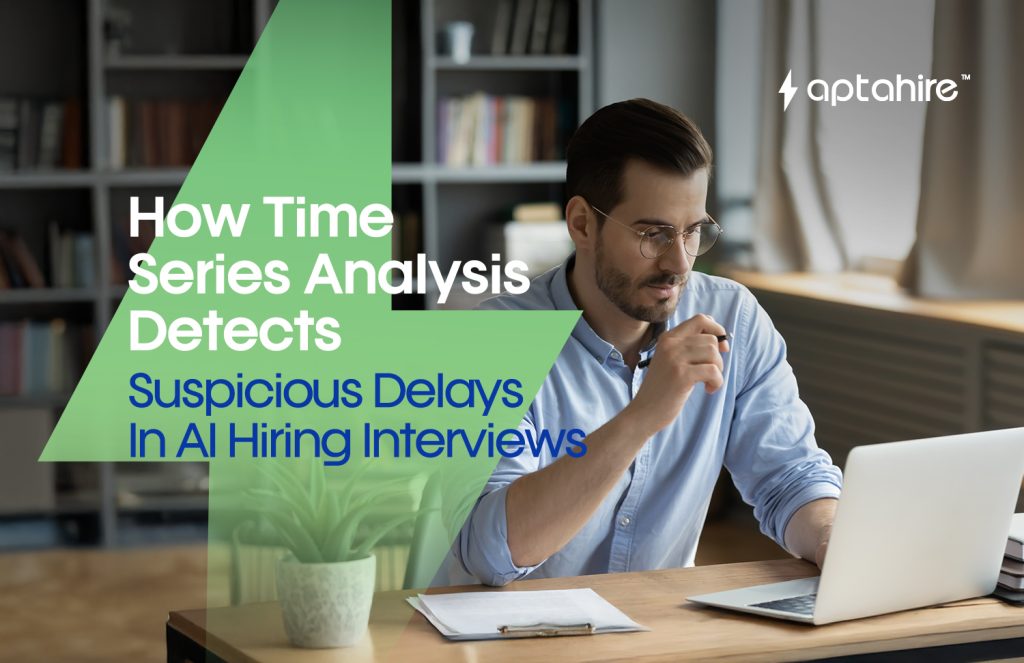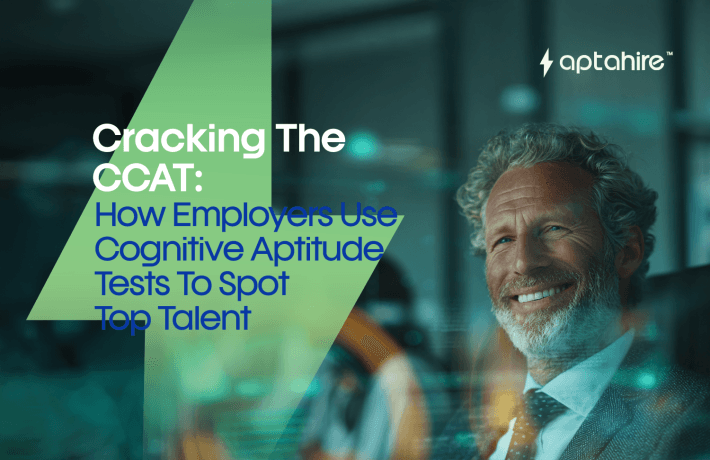How Time-Series Analysis Detects Suspicious Delays in AI Hiring Interviews

So you’re interviewing for a job, and instead of chatting with a human, you’re recording answers on a screen while some AI in the background is silently watching everything, how you talk, where you look, how long you take to answer… kind of creepy, right?
But here’s the thing: that AI isn’t just judging your vibe. It’s also paying close attention to how long you take to respond to each question. Why? Because timing can reveal a lot, especially when it comes to whether a candidate is being genuine or getting a little help on the side.
This is where time-series analysis comes in, a fancy term for tracking behavior over time. In this blog, I’ll walk you through how it works in AI-powered hiring, why it matters, and how it actually helps make interviews more fair (not more robotic).
Let’s get into it.
First Things First: What the Heck Is Time-Series Analysis?
Alright, picture this: you’re looking at a graph of your daily coffee intake over a month. Each point shows how many cups you drank on that day. That’s a time series, data points arranged in order over time.
Now, let’s say one random Wednesday you had six cups instead of your usual two. That spike is an anomaly, and if you’re analyzing that time series, you’d notice something odd happened that day. (Maybe a deadline?)
Time-series analysis is basically that, spotting patterns or weird blips in how something behaves over time.
In the hiring world, the “something” we’re tracking is how long a candidate takes to answer interview questions. And if that timing seems off compared to what’s normal, it can raise a red flag.
So Why Bother Watching Someone’s Timing?
Good question. You might think, “What’s the big deal if I take an extra 10 seconds to answer?”
Well, in remote AI interviews, where candidates are answering questions alone, without a live interviewer, it’s really easy to hit pause, look up the answer, or even have someone help off-screen.
Here’s what recruiters want to avoid:
- Candidates Googling answers mid-interview
- Someone feeding answers in the background
- People using ChatGPT or other tools to cheat
- Pre-recorded or AI-generated responses
These aren’t just “unfair.” They completely mess up the purpose of an interview, which is to see how you think and respond under pressure, not how well your friend behind the laptop does.
So, if someone consistently pauses too long or the timing just doesn’t feel natural, it’s worth looking into. That’s where time-series analysis becomes super useful.
Okay, But How Does It Actually Work?
Let’s break it down step by step, without the tech jargon overload.
Step 1: Tracking the Timeline
Every time a question pops up on your screen, the system starts a timer. It notes things like:
- When the question appears
- How long you wait before answering
- How long your answer lasts
- If you pause halfway through
All of this creates a timeline, kind of like a play-by-play of your interview.
Step 2: What’s “Normal” Behavior?
AI systems are trained using data from thousands of real candidates. So over time, they learn things like:
- How long people usually take to answer certain types of questions
- What natural pauses sound like (we all “umm” and “uhh” a bit)
- How long is too long for a pause before it gets sketchy
This helps the AI build a “baseline” of normal behavior, like how long most people take to answer a basic question versus a tricky one.
Step 3: Spotting Weird Timing
Now, when your timing is way off that baseline, the AI notices. For example:
- You take 30 seconds to start answering a simple question like, “Tell us about yourself.”
- Your pauses are long and oddly timed, not like someone thinking, more like someone waiting to be told what to say.
- All your answers are exactly the same length, like they were rehearsed or copied.
These patterns get flagged for review. Doesn’t mean you’re guilty, but it might be worth a closer look.
A Real-Life Example
Let’s say a candidate is asked:
“Tell me about a time you had to deal with a difficult teammate.”
Here’s what happens:
- The question pops up.
- The candidate waits… and waits… and finally starts speaking after 20 seconds.
- They talk for 30 seconds, pause awkwardly for 10, continue again, and then stop.
Now, if the AI’s seen that most people start answering this type of question in 4–6 seconds, and don’t have huge pauses in the middle, it’s going to notice the difference.
It doesn’t mean someone cheated. Maybe they were genuinely nervous or distracted. But if this weird timing happens over multiple questions, that’s when it becomes suspicious.
Why Not Just Set Time Limits?
Great point. Some older platforms did just that, like, “Answer within 15 seconds or you’re out.”
But here’s the problem: humans are unpredictable. Some people think faster, some slower. Some pause more. And some questions just take longer to answer.
That’s why time-series analysis is way better. Instead of relying on hard limits, it looks at patterns and context. It understands that one delay isn’t a big deal, but a series of unnatural delays might be.
It’s like the difference between having a teacher who knows how you usually perform and one who fails you for one bad test.
Behind the Scenes: Who Builds These Models?
People like data scientists, behavioral experts, and machine learning engineers work on these models. They use algorithms (like ARIMA or anomaly detection models, if you’re into the nerdy stuff) to train systems that can:
- Learn what “normal” timing looks like
- Adjust for different question types and difficulty
- Improve accuracy over time by learning from real cases
It’s not perfect. But it gets smarter as it goes, kind of like your favorite playlist getting better the more you use it.
What Have Companies Learned So Far?
From teams using these tools in real hiring scenarios, here’s what we’ve heard:
- Context is everything. A pause might mean cheating, or just a dog barking in the background.
- Timing + behavior = clarity. When combined with things like eye tracking or facial expressions, time-series analysis becomes even more accurate.
- People appreciate transparency. When candidates are told how AI monitors interviews (including timing), they’re more likely to trust the process.
- Humans still matter. AI flags behavior, but recruiters make the final call. No one’s getting hired or rejected solely because of a pause.
Is This Ethical?
Glad you asked, because ethics in AI hiring is a huge deal.
To be trustworthy, companies using time-series analysis need to:
- Protect candidate data (your timestamps shouldn’t end up on some weird server).
- Avoid bias (models should work fairly across genders, accents, and cultures).
- Explain what’s going on (no sneaky monitoring, be upfront).
- Always involve humans in hiring decisions.
Used responsibly, this tech can actually make hiring more fair by reducing human bias and holding everyone to the same standards.
The Future: Where This Is Going
We’re just scratching the surface. Here’s what’s coming next:
- Even smarter models that blend timing with voice, facial cues, and body language
- Real-time feedback that coaches candidates during practice interviews
- Adaptive interviews that change based on your response behavior
- More transparency, like showing candidates their own interview analytics
Time-series analysis is already changing the game, and it’s only going to get better.
So, What’s the Takeaway?
If you’re hiring in 2025, AI interviews are likely part of your toolkit. But just asking questions isn’t enough, you need to know if the answers are genuine.
That’s where time-series analysis comes in. It watches the clock, picks up on odd delays, and helps you spot when something’s not quite right.
It’s not about being Big Brother, it’s about making sure the interview is fair, real, and reliable for everyone.
So the next time you see a candidate take a little too long to answer a basic question, don’t just guess. Let the data do the talking.
Want help integrating this kind of analysis into your hiring platform? Or curious how it can improve your own recruitment process? Just ask, We’d be happy to help!
FAQs
1. What is meant by time series analysis?
Time series analysis is a statistical technique used to analyze a sequence of data points collected or recorded at specific time intervals (e.g., daily, monthly, yearly). It helps in understanding trends, seasonal patterns, and forecasting future values based on historical data.
2. What are the 4 components of the time series?
The four main components of a time series are:
- Trend (T) – The long-term movement or direction in the data (e.g., upward or downward).
- Seasonality (S) – Regular and repeating patterns or cycles over a specific period (e.g., monthly sales increases during holidays).
- Cyclic (C) – Long-term fluctuations not of fixed period, often linked to economic or business cycles.
- Irregular (I) or Random – Unpredictable or residual variations that are not explained by the other components.
3. What are the steps in time series analysis?
The general steps involved in time series analysis include:
- Data Collection – Gather time-based data at consistent intervals.
- Data Cleaning – Handle missing values, outliers, and ensure consistency.
- Visualization – Plot the data to identify patterns, trends, and anomalies.
- Decomposition – Separate the series into trend, seasonal, and residual components.
- Model Selection – Choose a suitable model (e.g., ARIMA, Exponential Smoothing).
- Model Fitting – Fit the model to historical data.
- Forecasting – Predict future values using the fitted model.
- Evaluation – Assess model accuracy using metrics like RMSE, MAE, etc.
4. What are the four methods for time series analysis?
The four common methods used for time series analysis are:
- Descriptive Analysis – Visualizing and summarizing time-based data.
- Decomposition Methods – Splitting a series into its components (trend, seasonality, etc.).
- Smoothing Techniques – Such as Moving Average and Exponential Smoothing to reduce noise.
- Model-based Methods – Such as ARIMA (Auto-Regressive Integrated Moving Average), SARIMA, or machine learning models.
5. What is time series and its types?
Time series is a sequence of observations measured at regular time intervals.
Types of time series include:
- Univariate Time Series – Involves a single variable over time (e.g., stock prices).
- Multivariate Time Series – Involves multiple variables recorded over time (e.g., temperature and humidity).
- Stationary Time Series – The statistical properties (mean, variance) do not change over time.
- Non-Stationary Time Series – The statistical properties change over time (e.g., trending or seasonal data).
6. What is the formula for time series analysis?
There is no single formula, but a general additive model for a time series is:
Y(t) = T(t) + S(t) + C(t) + I(t)
Where:
- Y(t) = Observed value at time t
- T(t) = Trend component
- S(t) = Seasonal component
- C(t) = Cyclical component
- I(t) = Irregular (random) component
Alternatively, in multiplicative form:
Y(t) = T(t) × S(t) × C(t) × I(t)
The choice between additive and multiplicative models depends on how the components interact (e.g., whether seasonal changes are constant or proportional to trend).



